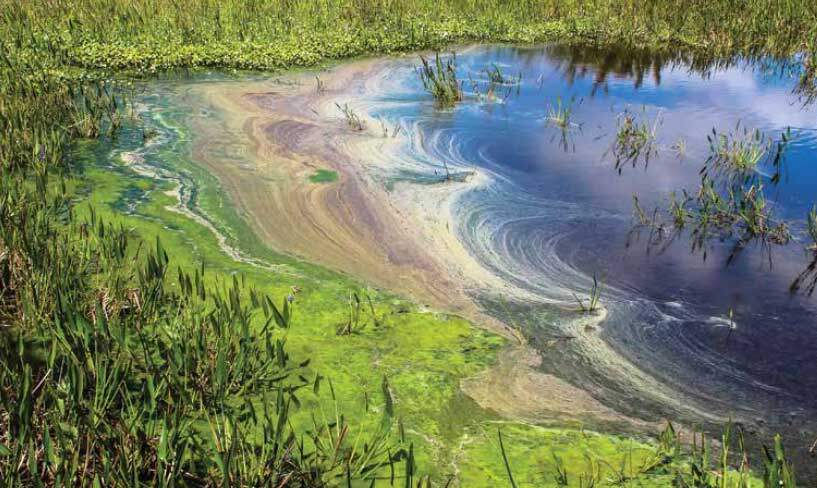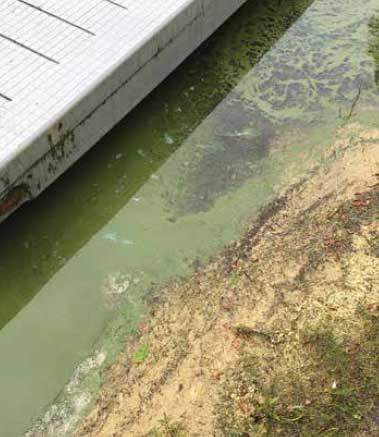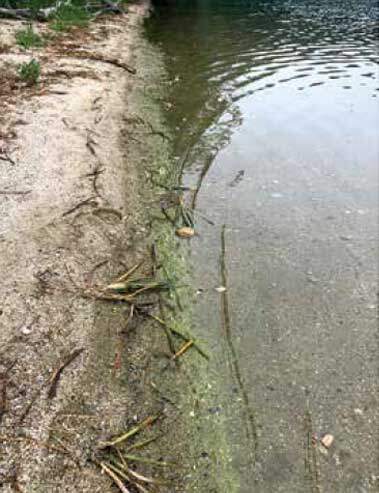PERIL IN THE POND
Avoiding the Dangers of Harmful Algae Blooms

Avoid the Dangers of Harmful Algae Blooms
by Jim Kennedy, National Pond Service
Do you know what you are looking at in this photo? This is not green algae or duckweed — it’s a bloom forming cyanobacteria, or sometimes called a harmful algae bloom.
Pond contractors working in aquatic environments should be aware of the dangers associated with cyanobacteria for their own health and for their customers’ safety.
What Are Cyanobacteria?
Cyanobacteria are group of photosynthetic bacteria found worldwide that can grow quickly when warm water combines with sunlight and nutrients like phosphorous and nitrogen. Cyanobacteria are naturally occurring organisms that have the ability to make their own food using organic compounds and sunlight. This form of bacteria has been on Earth since before the dinosaurs existed.
Whether you are working on a neglected garden pond or a larger pond, you could become exposed to a potential cyanotoxin. Some of the more common cyanotoxins are Dolichospermum, Oscillatoria, Microcystis and Chrysosporum, which produce cyanotoxins like anatoxin, cylindrospermopsin and microcystin. If you become exposed to some of these bacteria, you may experience strong headaches, vomiting and nausea, diarrhea, slurred speech and — hopefully not, but possibly — respiratory paralysis.

An expired surface scum (top) has regeneration growth next to the pond edge.
During September 2020, a suspected cyanobacteria bloom in Botswana was responsible for the death of 330 elephants that had consumed water from an infected pond. Our company was working during this time for a client in central New York State who had the same cyanotoxin in their pond that was responsible for killing the elephants.
What Should I Look For?
Educate yourself and your employees to be capable of recognizing the water conditions that exist to support a cyanobacteria bloom and cyanotoxins. They could manifest in a scum-forming surface bloom that resembles poured paint or a wispy bubble pattern on top of the water. Elevated cyanotoxin levels may persist for several weeks after a surface bloom subsides. A bloom may not always be visible, as in the case of pico-cyanobacteria, which may resemble planktonic pea-green water.
Bloom or no bloom, you should recognize what is in the water and make smart safety decisions. A recent U.S. Environmental Protection Agency publication called “Health Effects from Cyanotoxins” can provide you with good information to learn from and to share.
If you find yourself working on a pond that looks like it might have a harmful algae bloom developing, but you are not sure, you should wear personal protective equipment (PPE) and reduce your exposure. This includes preventing pond water from getting into your mouth and eyes and protecting against dermal exposure by wearing disposable gloves and protective clothing. You may want to wear a face respirator with organic vapor cartridges to reduce inhalation exposure from aerosol particles.

Potential cyanotoxin appearance in pond water

Potential cyanotoxin appearance in pond water

Cyanotoxins affects wildlife, crops and people living near bodies of water with high concentrations of microcystins. Species of cyanobacteria have been detected in lettuce irrigated with infected lake water.

A surface bloom is less likely to be toxic due to lower turbidity.
Look at the color turbidity of the water. Avoid it if it appears olive to dark green with less than 4 inches of visibility. If the water smells like the inside of your truck on a wet day, or you notice subsurface green particles the size of frozen peas, avoid it!
According to Dr. Nancy Leland from Lim-Tex, cyanobacteria toxicity levels may increase with turbidity and particle size.
A Health Hazard
During the past five years, we have been researching and developing a foundation of knowledge because of the increased exposure to cyanobacteria from working on ponds and aquatic habitats.
Personally, I have gotten sick from only a 15-minute contact with airborne cyanotoxins while collecting a water sample from a bloom forming surface scum on a large pond. After dinner that night, I said to my wife, “I feel like I’ve been drinking all day!” I had a wicked headache, felt dizzy and found myself talking really slowly. I ended up going to bed at 6:30 p.m. without unloading my truck or returning any calls. The next morning, I spoke with Dr. Leland, who said I had probably been exposed to a neurotoxin like BMAA from the surface scum.

This really hit home and reminded me of when a husband of a friend died from Lou Gehrig’s disease, or ALS, a few years back. This guy was in great shape and a very healthy outdoor enthusiast, but he became overexposed to cyanotoxins while doing something he was really good at — waterskiing. It’s still puzzling to explain how he contracted ALS, but one of the best spots to waterski is warm, calm water, which is ideal for sustaining cyanobacteria blooms.
Research scientists from the University of New Hampshire have found a strong connection between cyanobacteria and ALS. Dr. Jim Haney, professor of biological sciences at UNH, and his team have been working on a system for collecting aerosols produced by cyanobacteria to gain a better understanding of how the transfer of airborne cyanotoxins affects wildlife, crops and people living near bodies of water with high concentrations of microcystins.
Species of cyanobacteria have been detected in lettuce irrigated with infected lake water. High levels of microcystins have been measured in blueberries grown near a lake with frequent harmful algae blooms.
Much of this is new and evolving science that we, as pond professionals, need to be aware of. Think about ticks and Lyme disease and how awareness has grown over the past few decades.
How Do I Know?
Without collecting a water sample and sending it to a lab for testing, you may not have enough information to make a good decision. There are several types of “dipstick” field test kits available that will give you a quick indication of the presence of cyanobacteria in pond water. Of course, if you have the time, a better comprehensive option is to collect a water sample and send it to a testing laboratory for the evaluation of species type and toxicity. Try to find the closest testing lab to your location to reduce processing time and sample deterioration. Samples can be express shipped to firms like Lim-Tex Labs, Eurofins Abraxis and Green Water Laboratories.
After you have educated yourself about cyanobacteria and cyanotoxins, take the opportunity to turn lemons into lemonade by sharing your knowledge with your clients through social media and simple, factual company handouts. Please don’t scare them to the point that they are willing to “fill in the pond.” Instead, show your customer the pond condition and ask to collect a sample for testing. Until the water samples are processed, inform them to avoid contact with the water and to prevent pets or livestock from accessing the pond water. After all, dogs can be very susceptible to cyanotoxin poisoning. Schedule a follow-up meeting to discuss the test results and formulate a plan for improving the water quality.
In 2021, the Centers for Disease Control released preliminary guideline addressing the problem with cyanobacteria. We are at the elementary stage of understanding the health concerns associated with cyanotoxins (especially aerosol inhalation). Until more guidance is released, be smart and stay safe.
